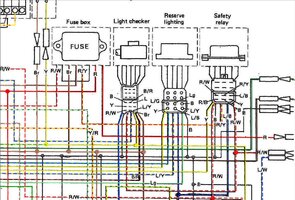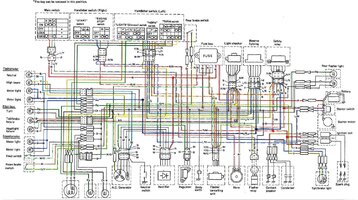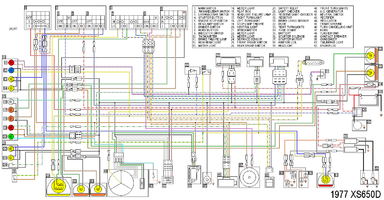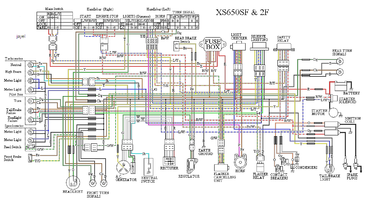Hi All,
Ok, so I've acquired an XS650F (established through the patience and help from numerous members - thanks) that I need to get MOT'd before registering it in the UK. I've sorted most of the issues out with the bike, like getting the indicators/turn signals to work, fitting a front brake light switch, changing all the fluids and getting the brakes working properly etc., BUT, I'm having a hell of a job trying to figure out why the headlight won't power up, neither lo or hi beam circuits.
I've poured over the wiring diagram for my model and am hoping those who understand the electrics on this bike can clarify a few issues.
Fuse Box
This bike should have a fuse box. It doesn't. Instead, someone has removed it and it appears they've simply joined up corresponding colour coded wires, R to R, R/W to R/W, Br to Br etc. I think this was done by the import dealer/seller of the bike, trying to sort out electrical issues.. However, when I look at the wiring diagram it appears there aren't corresonding pairs of wires entering/leaving the fuse box (see attached clip of wiring diagram). Is the wiring diagram missing some of the wires, i.e. what do the R/W and R/Y wires connect to? I simply want to understand the original fuse box layout because I'm not sure if the botched wiring is connected up correctly.
Reserve Lighting Unit
I've read somewhere that to remove this I simply need to bridge the L/B & L/Y wires and ignore the rest. is this correct?
Light Checker
How can I disable this unit? Do I need to bridge any wires at the plug, like the L/Y wire which appears to be the feed wire for the lights from the Main Switch, or can it simply be unplugged?
Safety Relay
Again, can this be unplugged, or do I have to do any bridging of plug terminals? I read somewhere that this unit can be removed if one plans to 'kickstart only', but can it still be removed if I want to keep the electric start?
Headlight Issue
So, with Main Ignition Switch on, my headlight has no power, on either circuit. I can move back to the LH handlebar switch and:
1. check continuity between L/Y at handlebar switch and Y & G wires at headlight
2. if 1 above is ok, check if there's power at the L/Y (blue/yell) wire at Lights/Dimmer switch on handlebar, as I assume this is the incomming feed wire for the headlight, is this correct?
If no power at Lights/Dimmer switch, I presume I:
3. check continuity of L/Y wire between Lights/Dimmer switch and RLU plug. If good, check if there's incomming power at the L/B (blue/black) wire, would this be correct so far?
If there's no power at the L/B wire then I'm not sure where I should go from here. Looking at the wiring diagram it looks as though if I jump the L/Y wire at the Light Checker to the L/y at the RLU plug I should have constant power to the hi / lo headlight circuits.
Help would be much appreciated.
Note: When I got the bike (RLU, Checker & Safety relay in circuit) someone had stripped back the sheath on the L/Y & L/B wires to the RLU, joined these two wires together with a jumper wire and ran this jumper wire to the R/W wire running between the Safety relay and the Starter Switch. I'm not sure why but assume they were trying to find power for the headlight. I have actually removed the jumper wire and repaired the L/B & L/Y wires, so I'm back to the original wiring config.
Ok, so I've acquired an XS650F (established through the patience and help from numerous members - thanks) that I need to get MOT'd before registering it in the UK. I've sorted most of the issues out with the bike, like getting the indicators/turn signals to work, fitting a front brake light switch, changing all the fluids and getting the brakes working properly etc., BUT, I'm having a hell of a job trying to figure out why the headlight won't power up, neither lo or hi beam circuits.
I've poured over the wiring diagram for my model and am hoping those who understand the electrics on this bike can clarify a few issues.
Fuse Box
This bike should have a fuse box. It doesn't. Instead, someone has removed it and it appears they've simply joined up corresponding colour coded wires, R to R, R/W to R/W, Br to Br etc. I think this was done by the import dealer/seller of the bike, trying to sort out electrical issues.. However, when I look at the wiring diagram it appears there aren't corresonding pairs of wires entering/leaving the fuse box (see attached clip of wiring diagram). Is the wiring diagram missing some of the wires, i.e. what do the R/W and R/Y wires connect to? I simply want to understand the original fuse box layout because I'm not sure if the botched wiring is connected up correctly.
Reserve Lighting Unit
I've read somewhere that to remove this I simply need to bridge the L/B & L/Y wires and ignore the rest. is this correct?
Light Checker
How can I disable this unit? Do I need to bridge any wires at the plug, like the L/Y wire which appears to be the feed wire for the lights from the Main Switch, or can it simply be unplugged?
Safety Relay
Again, can this be unplugged, or do I have to do any bridging of plug terminals? I read somewhere that this unit can be removed if one plans to 'kickstart only', but can it still be removed if I want to keep the electric start?
Headlight Issue
So, with Main Ignition Switch on, my headlight has no power, on either circuit. I can move back to the LH handlebar switch and:
1. check continuity between L/Y at handlebar switch and Y & G wires at headlight
2. if 1 above is ok, check if there's power at the L/Y (blue/yell) wire at Lights/Dimmer switch on handlebar, as I assume this is the incomming feed wire for the headlight, is this correct?
If no power at Lights/Dimmer switch, I presume I:
3. check continuity of L/Y wire between Lights/Dimmer switch and RLU plug. If good, check if there's incomming power at the L/B (blue/black) wire, would this be correct so far?
If there's no power at the L/B wire then I'm not sure where I should go from here. Looking at the wiring diagram it looks as though if I jump the L/Y wire at the Light Checker to the L/y at the RLU plug I should have constant power to the hi / lo headlight circuits.
Help would be much appreciated.
Note: When I got the bike (RLU, Checker & Safety relay in circuit) someone had stripped back the sheath on the L/Y & L/B wires to the RLU, joined these two wires together with a jumper wire and ran this jumper wire to the R/W wire running between the Safety relay and the Starter Switch. I'm not sure why but assume they were trying to find power for the headlight. I have actually removed the jumper wire and repaired the L/B & L/Y wires, so I'm back to the original wiring config.
Attachments
Last edited:




